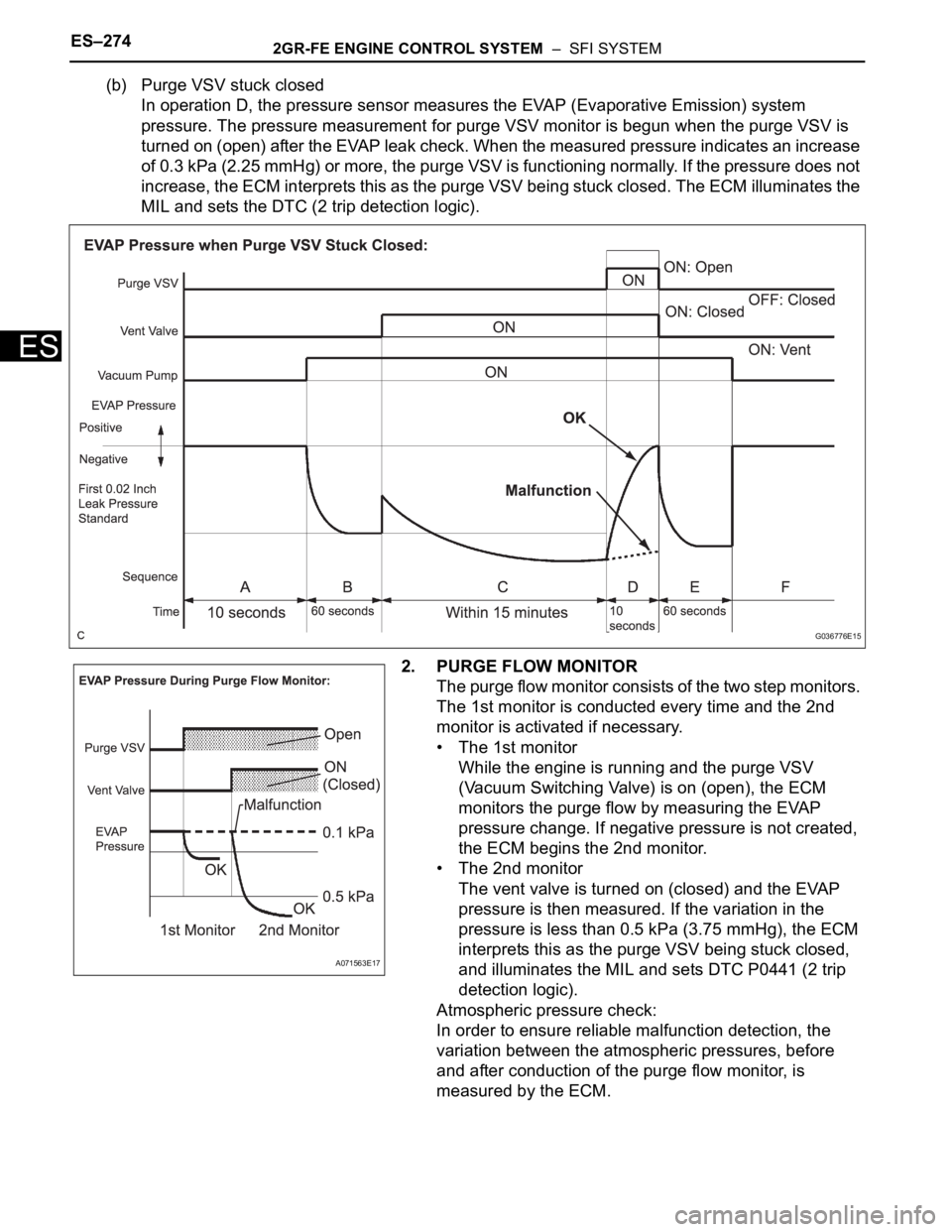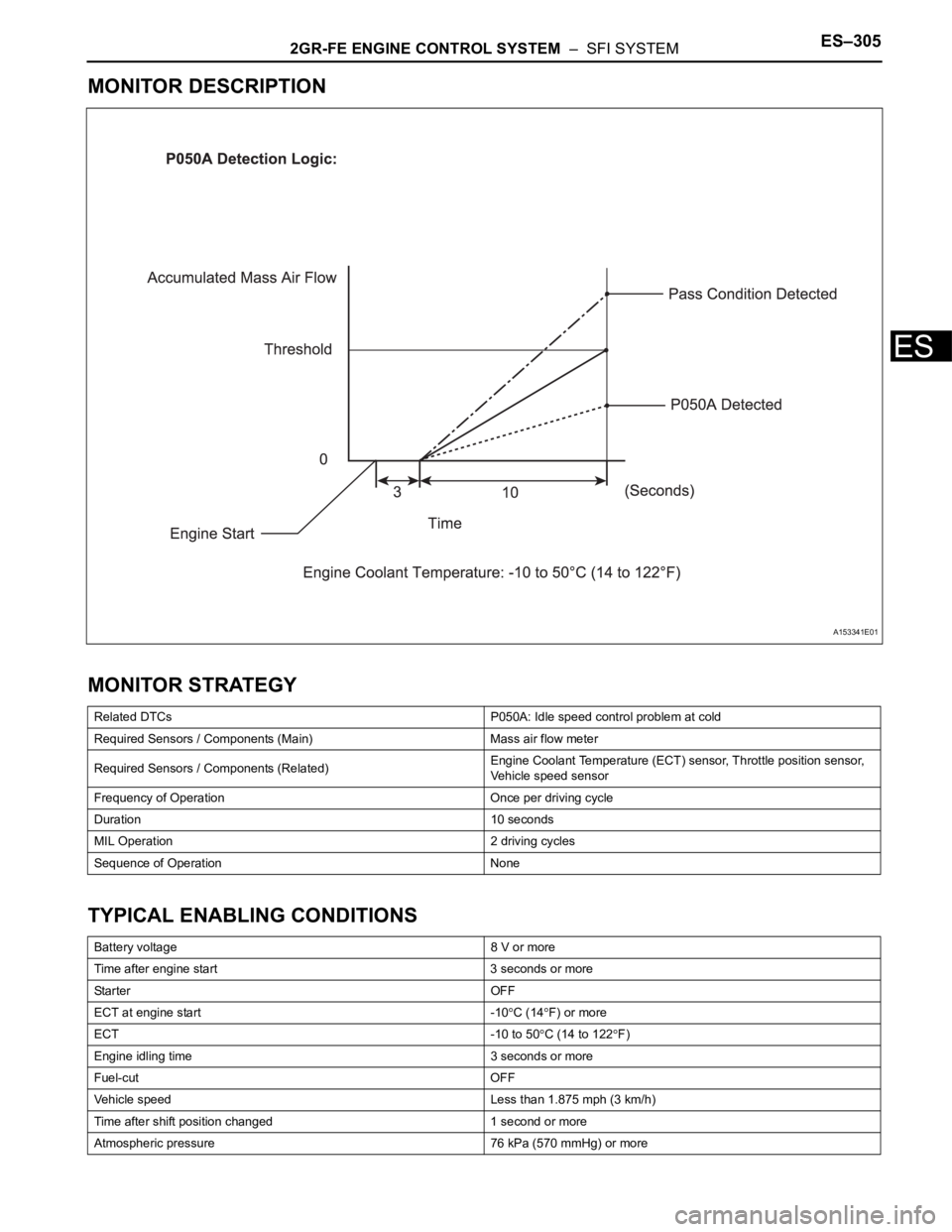2007 TOYOTA SIENNA change time
[x] Cancel search: change timePage 540 of 3000

ES–2342GR-FE ENGINE CONTROL SYSTEM – SFI SYSTEM
ES
DESCRIPTION
The intake camshaft's Variable Valve Timing (VVT) sensor (G signal) consists of a magnet and MRE
(Magneto Resistance Element).
The VVT camshaft drive gear has a sensor plate with 3 teeth on its outer circumference. When the gear
rotates, changes occur in the air gaps between the sensor plate and MRE, which affects the magnetic
field. As a result, the resistance of the MRE material fluctuates. The VVT sensor converts the gear
rotation data to pulse signals, uses the pulse signals to determine the camshaft angle, and sends it to the
ECM.
The crankshaft angle sensor plate has 34 teeth. The pickup coil generates 34 signals for each engine
revolution. Based on combination of the G signal and NE signal, the ECM detects the crankshaft angle.
Then the ECM uses this data to control fuel injection time and injection timing. Also, based on the NE
signal, the ECM detects the engine speed.
Reference: Inspection using an oscilloscope
DTC P0340Camshaft Position Sensor "A" Circuit (Bank 1
or Single Sensor)
DTC P0342Camshaft Position Sensor "A" Circuit Low
Input (Bank 1 or Single Sensor)
DTC P0343Camshaft Position Sensor "A" Circuit High
Input (Bank 1 or Single Sensor)
DTC P0345 Camshaft Position Sensor "A" Circuit (Bank 2)
DTC P0347Camshaft Position Sensor "A" Circuit Low
Input (Bank 2)
DTC P0348Camshaft Position Sensor "A" Circuit High
Input (Bank 2)
DTC No. DTC Detection Condition Trouble Area
P0340
P0345• Input voltage to ECM remains 0.3 V or less, or 4.7
V or higher for more than 5 seconds, when 2 or
more seconds have elapsed after turning ignition
switch ON (2 trip detection logic)
• No VVT sensor signal to ECM during cranking (1
trip detection logic)• Open or short in VVT sensor circuit for intake
camshaft
• VVT sensor for intake camshaft
• Camshaft timing gear for intake camshaft
• Jumped tooth of timing chain for intake camshaft
•ECM
P0342
P0347Output voltage of VVT sensor is 0.3 V or less for 5
seconds (1 trip detection logic)• Open or short in VVT sensor circuit for intake
camshaft
• VVT sensor for intake camshaft
• Camshaft timing gear for intake camshaft
• Jumped tooth of timing chain for intake camshaft
•ECM
P0343
P0348Output voltage of VVT sensor is 4.7 V or more for 5
seconds (1 trip detection logic)• Open or short in VVT sensor circuit for intake
camshaft
• VVT sensor for intake camshaft
• Camshaft timing gear for intake camshaft
• Jumped tooth of timing chain for intake camshaft
•ECM
Page 561 of 3000

ES–2682GR-FE ENGINE CONTROL SYSTEM – SFI SYSTEM
ESKey-off monitor sequence 1 to 8
1. Atmospheric pressure measurement
2. First reference pressure measurement
3. EVAP canister vent valve close stuck check
4. Vacuum introduction
5. EVAP canister purge valve close stuck check
6. Second reference pressure measurement
7. Leak check
8. Atmospheric pressure measurement
Time after key-off 5 or 7 or 9.5 hours
EVAP pressure sensor malfunction (P0450, P0451,
P0452, P0453)Not detected
EVAP canister purge valve Not operated by scan tool
EVAP canister vent valve Not operated by scan tool
EVAP leak detection pump Not operated by scan tool
Both of the following conditions 1 and 2 are met before
key-off-
1. Duration that vehicle driven 5 minutes or more
2. EVAP purge operation Performed
ECT 4.4 to 35
C (40 to 95F)
IAT 4.4 to 35
C (40 to 95F)
Next sequence is run if the following condition is met: -
Atmospheric pressure change Less than 0.3 kPa (2.25 mmHg) in 1 second
Next sequence is run if all of the following conditions
are met:Conditions 1, 2 and 3
1. EVAP pressure just after reference pressure
measurement-1 kPa (-7.5 mmHg) or less
2. Reference pressure -4.85 to -1.057 kPa (-36.384 to -7.929 mmHg)
3. Reference pressure Saturated within 1 minute
Next sequence is run if the following condition is met: -
EVAP pressure change after vent valve is ON 0.3 kPa (2.25 mmHg) or more
Next sequence is run if the following condition is met: -
EVAP pressure Saturated within 15 minutes
Next sequence is run if the following condition is met: -
EVAP pressure change after purge valve is open 0.3 kPa (2.25 mmHg) or more
Next sequence is run if all of the following conditions
are met:Conditions 1, 2, 3 and 4
1. EVAP pressure just after reference pressure
measurement-1 kPa (-7.5 mmHg) or less
2. Reference pressure -4.85 to -1.057 kPa (-36.384 to -7.929 mmHg)
3. Reference pressure Saturated
4. Difference between first reference pressure and
second reference pressureLess than 0.7 kPa (5.25 mmHg)
Next sequence is run if the following condition is met -
EVAP pressure when vacuum introduction was
completeLower than second reference pressure
EVAP monitor is complete if the following condition is
met:-
Page 563 of 3000

ES–2702GR-FE ENGINE CONTROL SYSTEM – SFI SYSTEM
ES
DTC SUMMARY
DESCRIPTION
The circuit description can be found in the EVAP (Evaporative Emission) System (See page ES-409).
INSPECTION PROCEDURE
Refer to the EVAP System (See page ES-412).
MONITOR DESCRIPTION
The two monitors, Key-Off and Purge Flow, are used to detect malfunctions relating to DTC P0441. The
Key-off monitor is initiated by the ECM internal timer, known as the soak timer, 5 hours
*1 after the ignition
switch is turned off. The purge flow monitor runs while the engine is running.
DTC P0441Evaporative Emission Control System Incorrect
Purge Flow
DTCs Monitoring Item Malfunction Detection Condition Trouble AreaDetection
TimingDetection
Logic
P0441Purge VSV (Vacuum
Switching Valve) stuck
openVacuum pump creates negative pressure
(vacuum) in EVAP system and EVAP
system pressure is measured. 0.02 inch
leak pressure standard is measured at
start and end of leak check.
If stabilized pressure is higher than
[second 0.02 inch leak pressure
standard x 0.2], ECM determines that
purge VSV is stuck open
• Purge VSV
• Purge VSV circuit
(between purge VSV
and ECM)
• Leakage from EVAP
line (between purge
VSV and intake
manifold)
• EVAP line clogged
(between purge VSV
and canister)
•ECMWhile
ignition
switch OFF2 trip
P0441 Purge VSV stuck closedAfter EVAP leak check is performed,
purge VSV is turned ON (open), and
atmospheric air is introduced into EVAP
system. 0.02 inch leak pressure standard
is measured at the start and end of leak
check.
If pressure does not return to near
atmospheric pressure, ECM determines
that purge valve is stuck closedWhile
ignition
switch OFF2 trip
P0441 Purge flowWhile engine running, the following
conditions are successively met:
• Negative pressure is not created in
EVAP system when purge VSV is
turned ON (open)
• EVAP system pressure change is
less than 0.5 kPa (3.75 mmHg) when
vent valve is turned ON (closed)
• Atmospheric pressure change before
and after purge flow monitor is less
than 0.1 kPa (0.75 mmHg)While
ignition
switch OFF2 trip
Page 567 of 3000

ES–2742GR-FE ENGINE CONTROL SYSTEM – SFI SYSTEM
ES
(b) Purge VSV stuck closed
In operation D, the pressure sensor measures the EVAP (Evaporative Emission) system
pressure. The pressure measurement for purge VSV monitor is begun when the purge VSV is
turned on (open) after the EVAP leak check. When the measured pressure indicates an increase
of 0.3 kPa (2.25 mmHg) or more, the purge VSV is functioning normally. If the pressure does not
increase, the ECM interprets this as the purge VSV being stuck closed. The ECM illuminates the
MIL and sets the DTC (2 trip detection logic).
2. PURGE FLOW MONITOR
The purge flow monitor consists of the two step monitors.
The 1st monitor is conducted every time and the 2nd
monitor is activated if necessary.
• The 1st monitor
While the engine is running and the purge VSV
(Vacuum Switching Valve) is on (open), the ECM
monitors the purge flow by measuring the EVAP
pressure change. If negative pressure is not created,
the ECM begins the 2nd monitor.
• The 2nd monitor
The vent valve is turned on (closed) and the EVAP
pressure is then measured. If the variation in the
pressure is less than 0.5 kPa (3.75 mmHg), the ECM
interprets this as the purge VSV being stuck closed,
and illuminates the MIL and sets DTC P0441 (2 trip
detection logic).
Atmospheric pressure check:
In order to ensure reliable malfunction detection, the
variation between the atmospheric pressures, before
and after conduction of the purge flow monitor, is
measured by the ECM.
G036776E15
A071563E17
Page 568 of 3000

2GR-FE ENGINE CONTROL SYSTEM – SFI SYSTEMES–275
ES
MONITOR STRATEGY
TYPICAL ENABLING CONDITIONS
All:
Purge flow:
Purge VSV stuck open and closed:
Key-off monitor sequence 1 to 8
1. Atmospheric pressure measurement
Related DTCsP0441: Purge VSV stuck open
P0441: Purge VSV stuck closed
P0441: Purge flow
Required Sensors / Components Purge VSV and pump module
Frequency of Operation Once per driving cycle
Duration Within 15 minutes
MIL Operation 2 driving cycles
Sequence of Operation None
The monitor is run whenever this DTC is not presentP0011, P0012 (VVT System 1-Advance, Retard), P0021, P0022 (VVT System 2-
Adavance, Retard), P0100, P0101, P0102, P0103 (MAF Sensor), P0110, P0112,
P0113 (IAT Sensor), P0115, P0116, P0117, P0118 (ECT Sensor), P0120, P0121,
P0122, P0123, P0220, P0222, P0223 , P2135 (TP Sensor), P0125 (Insufficient ECT
for Closed Loop), P0171,P0172 (Fuel System), P0300, P0301, P0302, P0303,
P0304, P0305, P0306 (Misfire), P0335 (CKP Sensor), P0340 (CMP Sensor), P0351,
P0352, P0353, P0354, P0355, P0356 (Ignitor), P0450, P0451, P0452, P0453 (EVAP
pressure Sensor), P0500 (VSS)
Engine Running
ECT 4.4
C (40F) or more
IAT 4.4
C (40F) or more
EVAP pressure sensor Not detected
EVAP canister purge valve Not operated by scan tool
EVAP system check Not operated by scan tool
Battery voltage 10 V or more
Purge duty cycle 8% or more
Atmospheric pressure 70 to 110 kPa (525 to 825 mmHg)
Battery voltage 10.5 V or more
Vehicle speed Less than 2.5 mph (4 km/h)
Ignition switch OFF
Time after key-off 5 or 7 or 9.5 hours
EVAP pressure sensor malfunction (P0450, P0452,
P0453)Not detected
EVAP canister purge valve Not operated by scan tool
EVAP canister vent valve Not operated by scan tool
EVAP leak detection pump Not operated by scan tool
Both of the following conditions 1 and 2 are met before
key-off-
1. Duration that vehicle driven 5 minutes or more
2. EVAP purge operation Performed
ECT 4.4 to 35
C (40 to 95F)
IAT 4.4 to 35
C (40 to 95F)
Next sequence is run if the following condition is met -
Atmospheric pressure change Less than 0.3 kPa (2.25 mmHg) in 1 second
Page 572 of 3000

2GR-FE ENGINE CONTROL SYSTEM – SFI SYSTEMES–279
ES
TYPICAL ENABLING CONDITIONS
All:
P0451 (Noise monitor):
P0451 (Stuck monitor):
P0450, P0452 and P0453:
TYPICAL MALFUNCTION THRESHOLDS
(a) P0450: Pressure sensor chattering
(b) P0451: Pressure sensor noise
(c) P0451: Pressure sensor stuck
(d) P0452: Pressure sensor low voltage
(e) P0453: Pressure sensor high voltage
DurationLess than 15 seconds: P0451 (Pressure sensor noise)
Within 2 minutes: P0451 (Pressure sensor stuck)
0.5 seconds: P0450, P0452, P0453
MIL OperationImmediate: P0450, P0452, P0453
2 driving cycles: P0451
Sequence of Operation None
The monitor will run whenever these DTCs are not
presentNone
Atmospheric pressure 70 to 110 kPa (525 to 825 mmHg)
Battery voltage 10.5 V or more
IAT 4.4 to 35
C (40 to 95F)
EVAP pressure sensor malfunction (P0450, P0452,
P0453)Not detected
Either of the following conditions 1 or 2 is met -
1. Engine condition Running
2. Time after key-off 5 or 7 or 9.5 hours
Battery voltage 10.5 V or more
IAT 4.4 to 35
C (40 to 95F)
EVAP pressure sensor malfunction (P0450, P0452,
P0453)Not detected
Atmospheric pressure 70 to 110 kPa (525 to 825 mmHg)
Time after key-off 5 or 7 or 9.5 hours
Ignition switch ON
Battery voltage 8 V or more
Sta r t e r OF F
EVAP pressure Less than 42.11 kPa (316 mmHg), or more than 123.761 kPa (928 mmHg)
Frequency that EVAP pressure change is 0.3 kPa (2.25
mmHg) or more10 times or more in 10 seconds
EVAP pressure change during reference pressure
measurementLess than 0.65 kPa (4.876 mmHg)
EVAP pressure Less than 42.11 kPa (316 mmHg)
EVAP pressure More than 123.761 kPa (928 mmHg)
Page 598 of 3000

2GR-FE ENGINE CONTROL SYSTEM – SFI SYSTEMES–305
ES
MONITOR DESCRIPTION
MONITOR STRATEGY
TYPICAL ENABLING CONDITIONS
Related DTCs P050A: Idle speed control problem at cold
Required Sensors / Components (Main) Mass air flow meter
Required Sensors / Components (Related)Engine Coolant Temperature (ECT) sensor, Throttle position sensor,
Vehicle speed sensor
Frequency of Operation Once per driving cycle
Duration 10 seconds
MIL Operation 2 driving cycles
Sequence of Operation None
Battery voltage 8 V or more
Time after engine start 3 seconds or more
Sta r t e r OF F
ECT at engine start -10
C (14F) or more
ECT -10 to 50
C (14 to 122F)
Engine idling time 3 seconds or more
Fuel-cut OFF
Vehicle speed Less than 1.875 mph (3 km/h)
Time after shift position changed 1 second or more
Atmospheric pressure 76 kPa (570 mmHg) or more
A153341E01
Page 635 of 3000

ES–3422GR-FE ENGINE CONTROL SYSTEM – SFI SYSTEM
ES
*: System guard set when following conditions met
TYPICAL MALFUNCTION THRESHOLDS
P2111 (Throttle actuator stuck open):
P2112 (Throttle actuator stuck closed):
FA I L - S A F E
When either of these DTCs, as well as other DTCs relating to ETCS (Electronic Throttle Control System)
malfunctions, is set, the ECM enters fail-safe mode. During fail-safe mode, the ECM cuts the current to
the throttle actuator off, and the throttle valve is returned to a 6
throttle angle by the return spring. The
ECM then adjusts the engine output by controlling the fuel injection (intermittent fuel-cut) and ignition
timing, in accordance with the accelerator pedal opening angle, to allow the vehicle to continue at a
minimal speed.
If the accelerator pedal is depressed slowly, the vehicle can be driven slowly.
Fail-safe mode continues until a pass condition is detected, and the ignition switch is then turned off.
WIRING DIAGRAM
Refer to DTC P2102 (See page ES-331).
INSPECTION PROCEDURE
HINT:
Read freeze frame data using the intelligent tester. The ECM records vehicle and driving condition
information as freeze frame data the moment a DTC is stored. When troubleshooting, freeze frame data
can be helpful in determining whether the vehicle was running or stopped, whether the engine was
warmed up or not, whether the air-fuel ratio was lean or rich, as well as other data recorded at the time of
a malfunction.
(a) Connect the intelligent tester to the DLC3.
(b) Turn the ignition switch to the ON position.
(c) Turn the tester on.
(d) Select the following menu items: DIAGNOSIS /
ENHANCED OBD II / DTC INFO / CURRENT CODES.
(e) Read the DTCs.
Result
Throttle actuator open duty-cycle 80% or more
Throttle actuator ON
Throttle actuator duty calculation Executing
Throttle position sensor Fail determined
Throttle actuator current-cut operation Not executing
Throttle actuator power supply 4 V or more
Throttle actuator Fail determined
TP sensor voltage change No change
TP sensor voltage change No change
1CHECK ANY OTHER DTCS OUTPUT (IN ADDITION TO DTC P2111 OR P2112)
Display (DTC Output) Proceed to
P2111 or P2112 A
P2111 or P2112 and other DTCs B